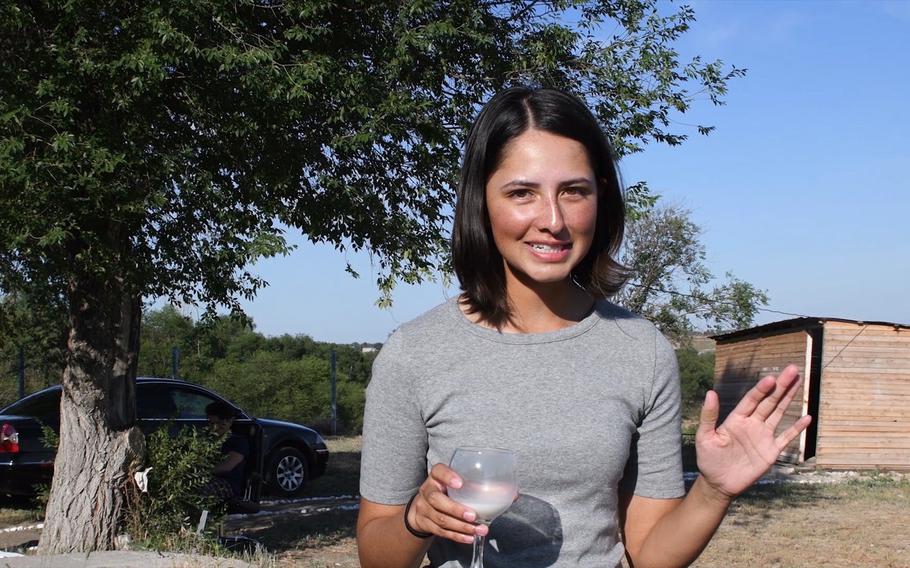
Army Spc. Shyla Alam, 22, tries fermented horse milk in Kazakhstan, where she was taking part in the U.S.-led Steppe Eagle exercise in June 2019. "Very sour," said Alam, a member of the Minnesota National Guard's 34th Infantry Division Headquarters Battalion. (J.P. Lawrence/Stars and Stripes)
ILLISKY TRAINING AREA, Kazakhstan — When in Kazakhstan, do as the Kazakhs do, the paraphrased old saying goes. And a big part of that, as soldiers taking part in the U.S.-led Steppe Eagle exercise here discovered, includes drinking horse milk.
Kumis, or fermented milk from a mare, was on the lips – at least in conversation terms – of many of the 400 troops from half a dozen countries who were in Kazakhstan for a U.S.-led exercise in peacekeeping and stability operations.
A traditional drink in this Central Asian country, horse milk is as easy to buy at one of the huts and shops that line local roads as sugary soft drinks are from a food truck in the United States.
At the start of Steppe Eagle, which ran from June 17 – 27, Sgt. Robert Walisko, a soldier with the British Army’s Princess of Wales’s Royal Regiment, bought a liter of horse milk for the equivalent of $1.50 from a roadside hut near the Illisky Training Area.
One sip and Walisko was sold on the drink. Often during Steppe Eagle, he could be overheard hatching a plan to seek investors so he could bring horse milk to England.
Walisko said he learned about horse milk from the Kazakh soldiers he trained. “It’s a throwback to the days when these guys were nomadic horse people, and would go long periods without seeing water,” Walisko told Stars and Stripes. “So they’d use horse milk.”
Kumis is made by fermenting raw, unpasteurized mare’s milk with yeast over several days. It is traditionally served warm.
Walisko struggled to describe what it tastes like, but had a ready descriptor for the smell: “Like a leftover pickle jar,” he said.
U.S. Army Staff Sgt. Anthony McGee, who also became a fan of horse milk during Steppe Eagle, said it tasted a bit like salted lassi, a yoghurt-based drink from South Asia, or melon-flavored kefir “with more of a sour aftertaste.”
Other soldiers were not won over by the drink.
Sgt. 1st Class Charles Hajko’s first, and only, experience with kumis involved drinking some of the local delicacy that had been poured out of a soda bottle stored in a warm bag that had been sitting out in the summer heat. A civil affairs soldier at Army Central, Hajko said he tasted the drink because he knew it would be rude to refuse an invitation to partake of someone else’s culture.
“I puked everywhere,” he recalled. “It was sour, and it was gross. I blew chunks all over.”
Capt. Jodine Pfaff, a soldier with the Minnesota National Guard’s 34th Infantry Division, described an “explosion of flavor, and not a good explosion” when she took a sip of kumis.
Watching the Americans’ reactions to kumis prompted a Kazakh soldier to acknowledge that horse milk is an acquired taste. The Western equivalent for him are potato chips. He can’t stand them, he said.
Improving understanding Steppe Eagle aimed not only to build the peacekeeping skills of troops taking part in the exercise but also to allow cross-cultural interactions that improve understanding of different ways of life, said Gen. Maj. Abubakirov, the commander of the Kazakh Air Assault Forces, at the opening ceremony in mid-June.
“When we train together with our partners and allies, we not only exchange our military experience, but also our cultural knowledge, and, thereby, we improve our understanding of one another,” Abubakirov was quoted by the Army as saying.
In addition to horse milk, cultural ice-breakers included nightly soccer games, where players disputed calls and celebrated goals in a mix of English, Russian and Farsi.
For one soldier, discovering the Kazakh culture involved going for a hike on his day off to a town five miles away from the training area.
On his way to the town, Sgt. First Class Kent Hecker, 41, said he stopped to watch a young father and his son fishing for carp in the river. The father gave the American a pole, the boy gave him some worms from a milk carton, and for 30 minutes, Hecker fished with them, he said. Although no one caught anything, he left with a selfie and a good mood.
Hecker also got a haircut, bought children some ice cream, and got in a push-up competition with some local boys during his hike – all without knowing a lick of Russian.
As for horse milk, Hecker said he grew up on a ranch in a small rural town in southwest North Dakota, and, despite several decades of riding and working with horses, never thought of drinking their milk.
But when in Kazakhstan, do as the Kazakhs do. So he tried it when he was here for Steppe Eagle.
The taste, Hecker said, was slightly bitter. Personally, he preferred camel’s milk, which he had tasted once near Dubai, he added.
His roommate Capt. Kevin O’Brien of the 34th Infantry Division, who helped plan Steppe Eagle, said he, too, has tried horse milk, but preferred a different local specialty: horse steak.
“Horse meat, I can confirm, is good,” O’Brien said. “Horse milk? Not so much.”
Twitter: @jplawrence3